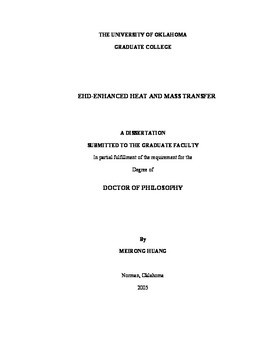| dc.contributor.advisor | Lai, Feng-Chyuan, | en_US |
| dc.contributor.author | Huang, Meirong. | en_US |
| dc.date.accessioned | 2013-08-16T12:19:56Z | |
| dc.date.available | 2013-08-16T12:19:56Z | |
| dc.date.issued | 2005 | en_US |
| dc.identifier.uri | https://hdl.handle.net/11244/931 | |
| dc.description.abstract | To study the mass transfer enhancement by the electric field, experiments have been conducted and the effects of corona wind (V0 = 14-20 kV), corona polarities (positive and negative), and cross-flow (ui = 2.2 m/s) on the evaporation rate of water have been carefully examined. Correlations have been proposed for the water evaporation rate under the application of electric field for both positive and negative corona polarities. Then, numerical models are developed for the electric, flow, and concentration fields. Numerical results have been compared with the experiment results and the agreement between them is found to be satisfactory. | en_US |
| dc.description.abstract | The present study has addressed some fundamental issues involved in the heat and mass transfer enhancement by electric field. To examine the heat transfer enhancement by the electric field, forced convection in a horizontal channel has been first numerically modeled using two-way coupling between the electric field and the fluid field. Heat transfer enhancement in the presence of electric field has been evaluated by employing both one-way and two-way coupling models. Numerical solutions have been obtained for a wide range of governing parameters (V0 = 10.0, 12.5, 15.0 and 17.5 kV as well as ui = 0.0759 to 1.2144 m/s). Since the difference in the results obtained by these two approaches is insignificant, it is concluded that the assumption of one-way coupling is valid. Then, the heat transfer enhancement by electric field is examined for natural convection in an enclosure with the effects of Joule heating. Numerical solutions have been obtained for three electrode locations and a wide range of governing parameters (Ra = 104, 105, and 106, and V 0 = 12, 15, and 18 kV). The results obtained show that the effects of Joule heating are negligible when the Rayleigh number is large (Ra ≥ 10 5). For a small Rayleigh number (Ra = 104), the effects of Joule heating are significant. | en_US |
| dc.format.extent | xvii, 152 leaves : | en_US |
| dc.subject | Mass transfer. | en_US |
| dc.subject | Engineering, Mechanical. | en_US |
| dc.subject | Heat Transmission. | en_US |
| dc.subject | Electric fields. | en_US |
| dc.title | EHD-enhanced heat and mass transfer. | en_US |
| dc.type | Thesis | en_US |
| dc.thesis.degree | Ph.D. | en_US |
| dc.thesis.degreeDiscipline | School of Aerospace and Mechanical Engineering | en_US |
| dc.note | Adviser: Feng-Chyuan Lai. | en_US |
| dc.note | Source: Dissertation Abstracts International, Volume: 66-12, Section: B, page: 6878. | en_US |
| ou.identifier | (UMI)AAI3203291 | en_US |
| ou.group | College of Engineering::School of Aerospace and Mechanical Engineering | |
